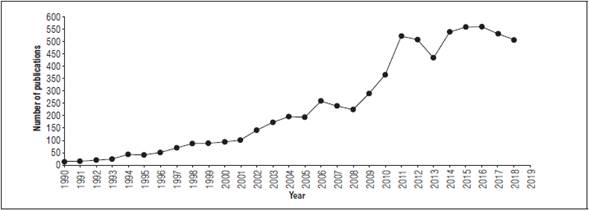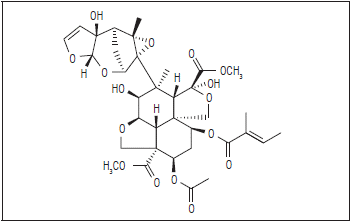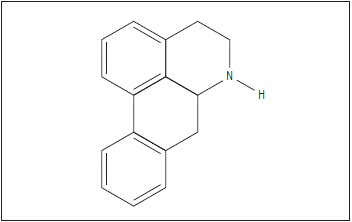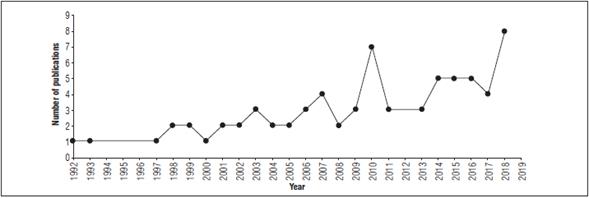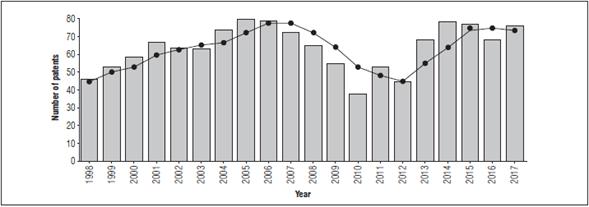RENAISSANCE: USE OF PRODUCTS OF NATURAL ORIGIN
The use of pesticides with a botanical origin goes back at least two millennia in China, Greece, Egypt, and India. For North America and Europe, the use of these pesticides began one hundred and fifty years before the appearance of synthetic pesticides (organophosphates, organochlorines, pyrethroids and carbamates). Worldwide, the use of natural insecticides has increased because of regulatory actions that control the indiscriminate use of synthetic pesticides that have harmful effects and negative impacts on air, soil and water (Isman, 2006; Benelli et al., 2015; Sánchez et al., 2019).
In the last twenty-five years, the tendency for healthy and sustainable agriculture in developed countries has increased the need to find products capable of controlling the pests that affect agriculture (Ehlers, 2011). Global production of biopesticides (3,000 t year-1) is increasing at an accelerated rate. The participation of biopesticides is 2.5% in the total pesticide market. The global trends for the Biocontrol markets show that the percentage of biopesticides has continuously increased since 1997, and this increase is expected to maintain a rate of change of 10% per year (Gupta and Dikshit, 2010).
The use of botanical insecticides is emerging as an important tool for protecting agricultural products and the environment. For this reason, the development of this subject is an interesting topic.
New trend: Biopesticides
Biological pesticides are derived from natural raw materials such as plants, animals, bacteria and minerals. They are used to attack a specific pest, offering an eco-friendly and effective solution for pest control and representing little or no danger to the environment or humans (Gupta and Dikshit, 2010; Pavela, 2014a).
Some benefits offered by biopesticides that make them preferable to conventional synthetic pesticides are: (i) they have a specific mode of action, (ii) they are biodegradable in nature, and (iii) they generate little waste (Pavela, 2014b).
Biopesticides include a lot of potential products that can be classified into three main types, such as: microbial pesticides and other entomopathogens, incorporated plant protectors (PIP) and biochemical pesticides (Sarwar, 2015). Botanical pesticides are classified in the latter and are an important group of natural crop protectors are often slow acting, and incorporate mixtures of biologically active compounds; no resistance develops in pathogens or pests In their basic form, botanical pesticides can be raw preparations of plants, such as powders from flowers, roots, seeds, leaves, stems, and essential oils. The formulas are commonly concentrated or liquid extracts (Isman, 2006; Pavela, 2016).
Botanical pesticides
Natural plant products have gained a lot of importance in recent years with researchers as natural sources of new insecticides (Pavela, 2016). It is estimated that more than 6,500 species of plants have been examined for anti-insect properties. Of these, more than 2,500 species belonging to 235 families have shown a bio pesticide activity (Celis et al., 2008; Walia et al., 2012). Table 1 shows families with plants that have different chemical groups for insect control (Tab. 1) (Castillo et al., 2010).
Table 1 Examples of the most common plants with activity for insect control.

Source: modified from Tello et al. (2010).
Annonaceae is a family of plants widely distributed in tropical and subtropical regions and includes approximately 2,400 species and 108 genera (Castillo et al., 2010). The Annonaceae family contains four economically important genera for fruit growing: Annona, Rollinia, Uvaria and Asimina. In recent decades, chemical studies on the Annonaceae family have intensified because of the discovery of molecules with broad potential in agriculture and medicine (González et al., 2014).
Mechanisms and importance of botanical pesticides
The insecticidal activity of plants is attributed to the presence of secondary metabolites (Castillo et al., 2010). These compounds can have diverse mechanisms of action (Celis et al., 2008; El-Wakeil, 2013; Miresmailli and Isman, 2014); besides insecticide activity, they have an insect static effect, meaning they can act as inhibitors (Eriksson et al., 2008), dissuasive of the oviposition (Dimetry, 2012), repellents (Peterson and Coats, 2001), anti-alimentary (Isman, 2006) and as growth regulators (Celis et al., 2008; Dimetry, 2012).
Some of the most successful natural products with application at the field level are obtained from neem (A. indica) (Benelli, 2015), essential oils, capsaicin oil (Capsicum annuum L.) (El-Wakeil, 2013) and preparations of Ryania speciosa Vahl (Murillo and Salazar, 2011).
Analysis of trends in scientific publications on botanical biopesticides
The analysis of scientific publications on botanical biopesticides was carried out according to the Scopus database. A comparative search was carried out with Web of Science, where a lesser registry of publications was obtained. According to the search parameters, the following search equation was used in Scopus: TITLE-ABS-KEY: (("botanic*pesticide*") OR ("biocides*organic*") OR ("biocides*natural*") OR ("plaguicide*botanic*") OR (biopesticides*) OR ("insecticidal*activity*") OR (antifeed*) OR (deterr*) OR (repell*) OR (acaricidal*) OR (biocida*) OR ("botanic*insecticide*") OR ("plant*extract*")) AND ((annonaceas*) OR (annona*) OR (Annonaceae*) OR (Rutaceae*) OR (Lamiaceae*) OR (Meliaceae*) OR (Asteraceae*) OR (Solanaceae*) OR (Asteraceae*) OR (Malvaceae*) OR (labiate*) OR ("essential*oil*"))
The number of publications on the topic on botanical biopesticides has an exponential trend; the first publication was found in 1947 (Fig. 1), entitled: "Annona species as insecticides", which observed that seed and root extracts of A. reticulata and A. squamosa showed insecticidal activity when in contact with Aphis fabae Scopoli Macrosiphoniella sanborni Takahashi and Macrosiphum solanifolii Ashm., and repellent activity against larvae of Plutella maculipennis Muller-Rutz (Harper et al., 1947). The Annonaceae family has been an important source of compounds with bio pesticidal activity since the 40s.
Until 1990, the dynamics of publications was from 1 to 7 articles per year. This topic has gained momentum since 2001, with more than 100 publications on average per year. For the years 2015 and 2016, a total of 559 and 560 publications were reached, respectively, resulting in the period of greatest production for biopesticides to date.
In general, the proportion of articles focusing on botanical insecticides has increased from 0.94% in 1989 to 8.81% in 2000, and increased to 40.12% in 2010, approximately 5 times greater. However, the last 8 years have seen the highest scientific production, representing 59.81% of the total information. This indicates that the dynamics of publications is in the growth phase and that, currently, this topic is of great interest worldwide.
In the scientometric analysis, it was found that the areas of knowledge with the greatest number of publications are: Pharmacology, Toxicology and Pharmaceutics (25.4%), Biochemistry, Genetics and Molecular Biology (17%), Medicine (16.2%) and Agriculture and Biological Sciences (16%). The largest number of publications has been made in the Journal of Ethnopharmacology. It is reported that most of the botanical biopesticides that are evaluated are extracts of leaves, seeds, roots, and essential oils. The most reported species with insecticidal activity is A. indica also known as neem tree. Azadirachtin (Fig. 2), which is a limonoid, has been reported as the main secondary metabolite in its seeds (Isman, 1997; Is-man and Grieneisen, 2014; Celestino et al., 2016; Costa et al., 2016).
Since pest control was one of the more interesting objectives in this review, many publications related to pests of greater economic importance at the agricultural level as well as those related to public health problems were highlighted (Mann and Kaufman, 2012).
In the first case, publications on controlling insects of the Lepidoptera order were found, especially studies on Spodoptera littoralis Boisduval (cotton leaf worm) and Spodoptera frugiperda Smith (corn fall armyworm). From the coleoptera order, studies were found on Tribolium castaneum Herbst, which highly affects stored products such as wheat, barley, rice, flours and bran, Sitophilus zeamais Motschulsky (corn weevil) and Callosobruchus maculatus Fabricius (bean weevil) (Ondarza, 2017). For studies on pests associated with public health problems, studies on insects of the order Diptera, Aedes aegypti Linnaeus (yellow fever mosquito), Anopheles stephensi Liston (malaria vector) and Culex quinquefasciatus Say (vector of filariasis) are of great interest (Benelli, 2015; Grzybowski et al., 2012).
With respect to anonaceous, the dynamics of publications increased in recent years by 12.01% in terms of articles. The greatest number of articles was in the period 2011-2012. Since 2004, an average of 60 publications per year has been maintained. The articles on this family showed that they are related to obtaining extracts from leaves and seeds and evaluating insecticidal activity in vitro. The most studied species included A. muricata and A. squamosa. Many publications were focused on pest control, such as A. aegypti and C. quinquefasciatus, which are of great importance for human health (Benelli, 2015).
Several Annonaceas studies were related to the isolation and characterization of compounds associated with bioactivity. Acetogenins are the main active compounds and are found mainly in the seed. These compounds contain cytotoxic, antitumor, and insecticidal activities, among others. Within this group of compounds, studies on gigantecin, bullatacin, rolliniastatin, and anonin (Fig. 3) stood out because of their great bioactivity (Rojas and Uribe, 2009; Gupta et al., 2011; Alara et al., 2012; González et al., 2014; Kedari and Khan, 2014; Ansante et al., 2015; Ma et al., 2017).
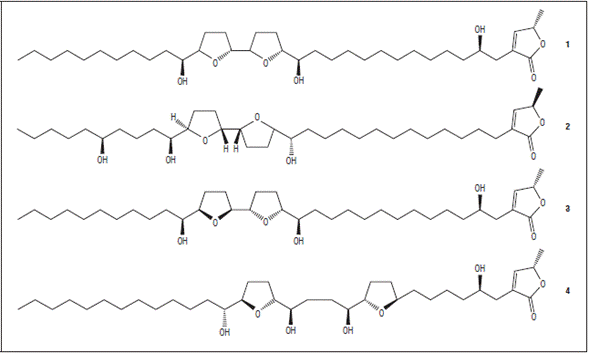
Figure 3 Structures of the acetogenins report (1) Bullatacin, (2) Annonin (3), Rolliniastatin, (4) Gigantecin.
They are also reported as active compounds of annonaceous, isoquinolic alkaloids, and phenolic compounds and, to a lesser extent, cycle peptides, vitamins, carotenoids, amides, carbohydrates, glycosides and volatile compounds (González, 2005; Cortes et al., 2014; Moghadamtousi et al., 2015; Ma et al., 2017; Coria et al., 2018). According to the studies, Annonaceae leaves are enriched with different types of isoquinoline alkaloids (Fig. 4), which are attributed similar effects as antidepressants; in some cases, neurotoxic effects are reported. The other compounds are distributed in different parts of the plant.
Although acetogenins and alkaloids are characterized as the main metabolites with insecticidal activity, the contribution of other types of metabolites such as peptide cycles has recently been considered. The case of Annomuricatin A, B and C isolated from A. muricata is particularly reported (Coria et al., 2018). There are also articles that demonstrate the toxicity of fatty acids, which is attributed to their amphibolic properties throught different mechanisms such as penetration, inhalation and contact (Moghadamtousi et al., 2015).
The content of metabolites varies for each species of Annonaceae (Coria et al., 2018; Ma et al., 2017), which is why some species have greater insecticidal activity with respect to others. But the bioactivity of extracts can be more promising for product development than the use of isolated compounds as active ingredients.
In addition, the following research is notable: Insecticidal activity of extracts of raw seeds of different plants against Lepidoptera larvae, where A. muricata and A. squamosa extracts were the most lethal (Leatemia and Isman, 2004a). According to several studies, acetogenins are the more important metabolites from this family, which present different biological activities (Ahammadsahib et al., 1993; Alali et al., 1999; Colom et al., 2007; Bajin ba Ndob et al., 2009; Moghadamtousi et al., 2015). The evaluation of extracts from different plant parts for the control of various pests (Leatemia and Isman, 2004a, 2004b; Odalo et al., 2005; Coelho et al., 2007; Deomena et al., 2007; Broglio-Micheletti et al., 2009; De Cássia et al., 2010; Barbalho et al., 2012; Roopan et al., 2012; Ribeiro et al., 2014) has established that botanical insecticides based on Annonaceae extracts can be very suitable for the integral management of pests.
Dynamics of publications by country: domination of India
According to the results (Fig. 5), there was a clear trend, where India dominated as the country with the highest number of publications, representing 19.88%, followed by Brazil (10.2%) and China (7.24%). In a more detailed analysis, the increase in publication for these countries started in 2011; for India, there was an average of 173 publications per year. In Brazil, the figures were approximately 88 per year and in China 63 per year.

Figure 5 Institutions or affiliations that research biopesticides by country, obtained from Scopus using the equation of search.
On the other hand, the analysis indicated that research in the Americas is based, for the most part, on the development presented by Brazil, the United States and Mexico. However, to a minor extent, there are emerging countries on the subject such as Canada, Colombia and Argentina.
At the national level, Colombia represents 1.02% with 71 publications; it is an emerging country in this area. The dynamic for the analysis of scientific publications on botanical biopesticides from 1992 to 1997 showed little scientific production was developed (Fig. 6). 2018 was the year with the most publications.
Notable there were publications on the families Asteraceae, Piperacea, Solanaceae and Annonaceae. Approximately 40% of the articles evaluated the essential oil of the plants and included chemical characterization by Gas Chromatography coupled to Mass Spectrometry (GC-MS). The studies focused on repellent activity. The other 40% of the articles referred to the use of extracts obtained mainly from seeds and leaves. The focus was on the evaluation of insecticidal activity in vitro, without including chemical characterization in most cases. The remaining percentages were related to the isolation of different metabolites in order to potentiate the activity.
The more reported pests included the genera Diptera, Lepidoptera and Coleoptera. The more studied species correspond to: A. aegypti (yellow fever mosquito), T. castaneum (red flour weevil), Drosophila melanogaster Meigen (fruit fly), and Spodoptera frugiperda (fall armyworm in maize) (Nerio et al., 2010; Ratnadass et al., 2012).
15 articles related to research of the Annonaceae family were found in the bibliographic search, and 3 of these were reviews. Among the publications, "Activity insecticidal in vitro of the Annona spraguei Saff (Annonaceae) in two models' biologics of order Diptero: D. melanogaster y A. aegypti” was cited (Granados et al., 2001). In the Colombian entomology journal, there were two articles: one of them on the insecticidal effect of Annona muricata L. seed extracts and the other on three species of guatteria (Annonaceae) controlling A. aegypti, with promising results (Aciole et al., 2011).
Bearing in mind that Colombia is an origin center for Anonaceae (Murillo, 2001) and, according to the bibliographic review at the national level, there are important studies on this family (Giraldo-Rivera and Guerrero-Álvarez, 2018), There is a tendency towards studies on public and agricultural health problems (Muñoz et al., 2013; Ríos et al., 2017); research on this family must continue. Therefore, there is an opportunity to obtain and evaluate extracts with bio pesticide potential for the control of pests of economic importance.
Scientific production vs. Patenting
To obtain an overview of the patent dynamics on the subject, we consulted the Patent Inspiration and The Lens International Databases. A search equation was established according to the code of the international patent classification (IPC Code): search the IPC path: A HUMAN NECESSITIES; A01; A01N; A23); A61K; C05G; A01N65/00; AO1N65/08. The results of the search yielded a total of 1692 patents.
General patents dynamics: Patents related to biopesticides enjoyed interest in the 80s; however, since 1989, there has been an increase in patents related to this topic. The dynamics of patenting is growing, with the last 30 years having the greatest number of granted patents (Fig. 7), representing 90% of the total patents of the analyzed period.
The United States is among the countries that lead botanical bio pesticide patents, with 261 assigned patents, corresponding to 15.4% of the total number of patents. The United Kingdom has 188 patents, and France is in third place with 166 patents, with percentages of participation of 11.1% and 9.81%, respectively. As for Latin American countries, Mexico has 12 patents, Chile has 8 and Colombia has 7 patents.
The following general conclusions were obtained from the analysis of 50 patents: Biocides from the class Magnoliopsida and from the families Lamiaceae, Myrtaceae, Asteraceae and Rutaceae stand out. The biological control of insects and nematodes is the main use for these developments. The main novelty s is seen in the composition; the greatest advantage is the use of mixtures for their synergistic effect. Patenting botanical biocides protects the methods of obtaining the extracts and the composition of the final mixture.
There are few patents related to extracts of Annonaceae, which are related to the isolation of compounds with bioactivity from species such as A. reticulata, A. squamosa and A. muricata. The use of acetogenins, such as squamocin and annonacin as active ingredients of products for the control of different pathological pests was notable. The combination of Annonaceae extracts with other species of the Piperaceae family was also reported as a strategy for the control of A. aegypti (Universidade Federal do Paraná, 2015; Yong, 2015).
Nowadays, there is a product derived from Annonaceae, which is known as ANOSOM® (Agri Life, India) and has the active ingredient squamocin, obtained of Annona squamosa L. Studies have indicated that the mode of action of this compound for insecticidal and fungicidal activity is inhibiting mitochondrial Complex III.
A growing market
Regulatory requirements, such as government policies and environment protection laws in different countries, restrict pest control market agents because regulatory requirements in terms of the environment are becoming stricter and more stringent, resulting from an increase in demand for organic agricultural products.
In Europe, Commission Regulation EU 2017/1432, which amends Regulation (EC) No 1107/2009 (European Commission, 2017), authorized the review of pesticides, and their use was agreed to in European countries. During this evaluation, about 70% of the active materials were banned from the Market. The objective was: "to reduce the risks and impacts of the use of pesticides on human health and the environment while promoting the development and introduction of IPM together with alternative techniques, in order to reduce the dependence on the use of chemical pesticides.' Meadows-Smith noted that the global tendency towards low environmental impact supplies, called "Low Chem'', presented a huge opportunity for the bio pesticide industry.
The market for biopesticides is projected as the fastest growing market because of growing demand from farmers. According to the report posted by Transparency Market Research, the biopesticides global market was valued at US$ 1.72 billion in 2014. Additionally, driven by the growing concern for sustainability, new regulations and population growth, this industry can reach US$ 4.17 billion by 2023 and 9 billion dollars by 2050. For the use of bio pesticides, 80% are used to protect crops of high economic value such as fruits and vegetables, largely because they do not leave residues, something very appreciated by consumers (ReportsnReports, 2015).
North America is expected to dominate the global bio pesticide market in terms of demand (Markets and Markets, 2017). In 2015, it represented the largest market share, followed by Asia-Pacific and Europe.
Increased awareness of the benefits of biopesticides among growers and the increase in population are causing market growth in this region. Central and South America account for 10% of the global market for bio pesticides, and Brazil represents the largest market in Latin America (72.47%), followed by Argentina.
The Asia Pacific market presents a great opportunity for bio pesticides, driven by the mega-economies of China and India. For its part, China, given its extensive area, has directed efforts for the sustained use of bio pesticide with strategies such as providing subsidies to farmers or planting bases for the use of bio pesticides. In India, according to the Ministry of Agriculture, biopesticides account for just 2.89% of the 100,000 metric tons of the pesticides market but could increase to a rate of 2.3% per year (Markets and Markets, 2016).
The main companies identified in the global bio pesticide market were Bayer Crop Science (Germany), BASF SE (Germany) and Monsanto Company (USA). These large global companies invest in new biopesticides development with different active ingredients and have implemented programs of Integrated Pest Management. The most important players in the market have explored new places, promoting new products, cooperations and acquisitions around the world in order to achieve benefits through combined synergies. Since 2011, the bio pesticide market has experienced an increase in demand, mainly in countries such as Spain, Canada, Brazil, China and India (Markets and Markets, 2017).
In Colombia, the registration and control of chemical pesticides for agricultural use is regulated by Decision 804 (Andean Community, 2015). In Resolution 534 (ICA, 2012), provisions were made for the preparation and registration of chemical products for agricultural use. Resolution 698 (ICA, 2011) dictates the provisions for the Registration and Control of Bio-inputs and Vegetable Extracts of Agricultural Use in Colombia.
At a national level and according to the report presented by the Colombian Agricultural Institute (ICA) and the Ministry of Agriculture and Rural Development on Bio-input companies (December 2019), 36 companies are producers and importers, which work in the development of bio-pesticides from plant extracts. The companies that stand out at the national level include Eco flora Agro, ADN verde, Agro Biológicos del Ajo, Orgánicos de Colombia and Green seal company, which develop plant extracts for effective and sustainable crop protection (ICA, 2019).
CONCLUSIONS
This review for botanical biopesticides o established that there is a potential interest in research and in the subsequent development of biocides using extracts of botanical origin, where the Annonaceae family is promising.
Although secondary metabolites with biocidal activity have been identified, it is necessary to delve further into composition studies on the promissory extracts because the examined documents indicate that a chemical characterization of the extracts is lacking.
The evaluation of synergistic mixtures and field tests should be encouraged for new product development for pest control that will affect crops and human health.
The analysis of the market trend of botanical biopesticides indicated that it is growing and that there is great opportunity for Latin America and for Colombia because of its great diversity of plants.













